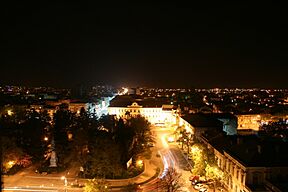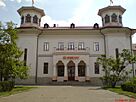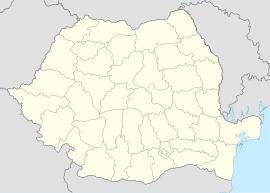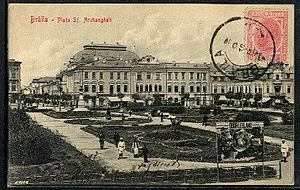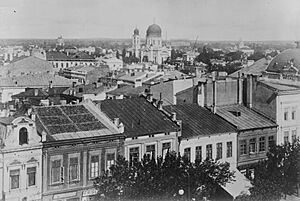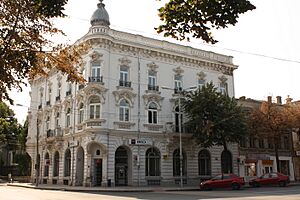Brăila facts for kids
Quick facts for kids
Brăila
|
||
|---|---|---|
|
From left: Overview of the city (night view), Maria Filotti Theatre, Hotel Danubiu, Old town, Lyra Palace, St. Nicholas Church, Headquarters of the Naval Authority, Traian statue.
|
||
|
||
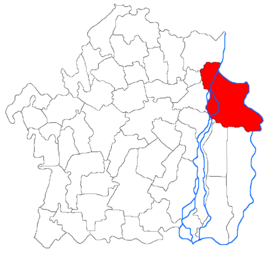
Location in Brăila County
|
||
| Country | ||
| County | Brăila | |
| Area | 77.9 km2 (30.1 sq mi) | |
| Elevation | 25 m (82 ft) | |
| Population
(2011)
|
Lua error in Module:Wd at line 1,575: attempt to index field 'wikibase' (a nil value). | |
| Time zone | EET/EEST (UTC+2/+3) | |
| Postal code |
810xxx
|
|
| Area code | (+40) 239 | |
Brăila is a city in eastern Romania. It is an important port city located on the Danube River. Brăila is also the capital of Brăila County.
In 2021, about 154,686 people lived in Brăila. This makes it one of the largest cities in Romania. It is also one of the biggest cities found along the Danube River. The current mayor of Brăila is Viorel Marian Dragomir.
Contents
History of Brăila
How Brăila Started
Before the 1300s, Brăila was a small village. It was likely home to fishermen and traders. The village was taken over by the Mongols in 1241. Later, it was controlled by rulers from Curtea de Argeș.
Some old maps from the 1300s show a place called Drinago. This might have been an early name for Brăila. In Greek writings, the city was called Proilabum or Proilava. This was a Greek version of its Slavic name, Brailov. The exact meaning of the name Brăila is still a mystery.
The first official paper mentioning Brăila was from Vladislav I of Wallachia. He gave special rights to German merchants. They could travel through Brăila to the Danube without paying extra fees.
Brăila as a Wallachian Port
After another town called Vicina fell, Brăila became the main port for Wallachia. It became a town around the year 1400.
In 1396, a traveler named Johann Schiltberger wrote that ships docked in Brăila. These ships brought goods from faraway lands. Foreign merchants had to unload their goods here. An Ottoman record from 1520 mentions 70-80 ships arriving in Brăila. They brought goods from Asia Minor and Crimea. The town was also a big center for trading fish. Polish merchants came to buy fish, and rulers taxed this trade.
Brăila had its own local government. It was run by local leaders called pârgari and a județ. The town was likely very diverse, with people from many different backgrounds living there.
In 1462, a large fleet led by Mehmed the Conqueror burned the city. Brăila was also caught in fights between Wallachia and Moldavia. Moldavian Prince Stephen the Great destroyed the city during a war.
Brăila competed with another Moldavian town, Chilia. Despite the conflicts, Brăila always recovered. It quickly became a gateway for goods from the Levant into Wallachia. The city was burned again in 1512 by Bogdan III of Moldavia.
Brăila as an Ottoman Port
Around 1538–1540, Brăila became part of the Ottoman Empire. The Ottomans called it Ibrail or Ibraila. They built a strong stone fortress in the town.
The Ottoman Empire ruled Brăila until 1829. For a short time, Michael the Brave, a prince of Wallachia, ruled it from 1595 to 1596. But the Ottomans soon took it back.
Modern History of Brăila
In 1711, a Wallachian and Russian army took over the city. In 1828, Brăila was under siege again. In 1829, it was given back to Wallachia.
During the 1800s, Brăila's port became one of the three most important ports on the Danube in Wallachia. The city was most successful in the late 1800s and early 1900s. It was a key port for many goods coming into and leaving Romania.
During World War II, Soviet troops captured Brăila on August 28, 1944. This happened during a big military operation.
After the Romanian Revolution of 1989 in 1989, Brăila's economy faced some challenges.
Population of Brăila
| Historical population | ||
|---|---|---|
| Year | Pop. | ±% |
| 1859 | 15,767 | — |
| 1900 | 58,392 | +270.3% |
| 1912 | 65,053 | +11.4% |
| 1930 | 68,347 | +5.1% |
| 1941 | 99,531 | +45.6% |
| 1948 | 95,514 | −4.0% |
| 1956 | 102,500 | +7.3% |
| 1966 | 138,802 | +35.4% |
| 1977 | 194,633 | +40.2% |
| 1992 | 234,110 | +20.3% |
| 2002 | 216,292 | −7.6% |
| 2011 | 180,302 | −16.6% |
| 2021 | 154,686 | −14.2% |
| Censuses data, 1930–1948. | ||
In 2021, Brăila had 154,686 people living there. This was a decrease from the 2011 count. Most of the people living in Brăila are Romanians. There are also smaller groups like Lipovans and Roma.
Brăila's Metropolitan Area
Geography of Brăila
Brăila is located in an important area called the Focșani Gate. This area is known for its strategic location.
Economy of Brăila
Brăila's port can be reached by small and medium-sized ocean ships. It has large facilities for handling grain and storing goods. The city is also an important industrial center. It has factories for metalworking, textiles, and food processing. The naval industry, which builds and repairs ships, is a major source of income for Brăila.
City Layout and Districts
Streets in Brăila spread out from the port towards the city center. They are crossed by circular streets. This pattern comes from the design of the old Ottoman defenses.
Brăila has several districts, including Centru (Center), Viziru (1, 2, 3), Călărași 4, and Radu Negru. Other districts are Obor, Hipodrom, Lacu Dulce, Dorobanți, 1 Mai, Comorofca, Calea Galați, Gării, Apollo, Siret, Pisc, Brăilița, Vidin-Progresul, Islaz, and Chercea.
Landmarks in Brăila
The old part of the city has many buildings from the 1800s. Some of these have been fully restored. Important landmarks include the Greek Church, built by the Greek community. The Church of the Holy Archangels Michael and Gabriel was once a mosque during Ottoman rule. It is the oldest church in the city.
Other notable places are the 19th-century St. Nicholas Church and the Maria Filotti Theatre. There is also the Palace of Culture, which has an Art Museum, and the History Museum. The old Water Tower has a restaurant that slowly rotates, offering great views. The city also has the Palace of Agriculture from the 1900s.
The Public Garden is another important spot. It's a park on the bank of the Danube River with views of the river and the Măcin Mountains. In 2006, the city received money from the European Union to fix up the old city center. The goal is to make Brăila a popular place for tourists.
The Monument Park is one of Romania's largest city parks, covering about 90 hectares. It has a Natural Science exhibition from the Brăila Museum. This exhibit shows the plants and animals of the region. Brăila also has an Armenian Apostolic church from the 1800s.
Transportation in Brăila
Brăila has one of Romania's oldest electric tram lines. It started in the late 1800s and is still used today. The city's bus system is run by the town hall and Braicar Company. There are four main bus routes that cover most of the city. Brăila also has a train station.
Culture in Brăila
Local News
The city has several local newspapers. These include Obiectiv-Vocea Brăilei, Monitorul de Brăila, Ziarul de Brăila, and Arcașu.
Rivalry with Galați
Brăila has a strong rivalry with its nearby city, Galați. This friendly competition has a long history. It has even been studied by experts. A group of Romanian researchers wrote a book about it called Galați – Brăila. Trecut. Actualitate. Perspective.
Famous People from Brăila
- Petre Andrei
- Ana Aslan
- Anton Bacalbașa
- George Baronzi
- Daniela Buruiană
- Beatrice Câșlaru
- Alexandru Chipciu
- Georgia Crăciun
- Anișoara Cușmir-Stanciu
- Hariclea Darclée
- Catrinel Dumitrescu
- Constantin von Economo
- Andreas Embirikos
- Gabriela Enache
- Maria Filotti
- Liviu Floda
- Pnina Granirer
- Paulică Ion
- Nae Ionescu
- Panait Istrati
- Joseph M. Juran
- Antigone Kefala
- Valentin Mavrodin
- Manea Mănescu
- Ștefan Mihăilescu-Brăila
- Gheorghe Mihoc
- Mina Minovici
- Diana Mocanu
- Petru Mocanu
- Jean Moscopol
- Serge Moscovici
- Valeriu Niculescu
- Perpessicius
- Alina Popa
- Camelia Potec
- Nicolae Rainea
- Johnny Răducanu
- Eugen Schileru
- Mihail Sebastian
- Tudorel Stoica
- Costică Toma
- Christos Tsaganeas
- Andrei Tudor
- Mihai Tudose
- Ida Verona
- Ilarie Voronca
- Eléna Wexler-Kreindler
- Iannis Xenakis
- Marius Zirra
International Connections
Twin Towns and Sister Cities
Brăila has special partnerships with other cities around the world. These are called twin towns or sister cities:
 Pleven in Bulgaria.
Pleven in Bulgaria. Shumen in Bulgaria.
Shumen in Bulgaria. Calais in France.
Calais in France. Argostoli in Greece.
Argostoli in Greece. Katerini in Greece.
Katerini in Greece. Bitola in North Macedonia.
Bitola in North Macedonia. Kavadarci in North Macedonia.
Kavadarci in North Macedonia. Denizli in Turkey.
Denizli in Turkey. Nilüfer in Turkey.
Nilüfer in Turkey. Beşiktaş in Turkey.
Beşiktaş in Turkey.
Images for kids
See also
 In Spanish: Brăila para niños
In Spanish: Brăila para niños


